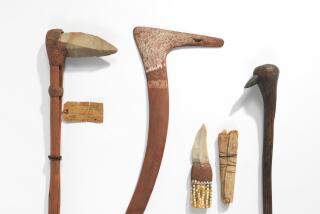Tribal Artifacts Slowly Returning to Indians
FORT APACHE, Ariz. — Log buildings still standing among the wind-battered pinons create the illusion that not much has changed here since this onetime Army post was established on Indian land in the late 19th century.
But to Ramon Riley, something crucial is missing from the fort that now is host to the White Mountain Apache Tribe’s cultural center. He’s trying to use federal legislation to bring back sacred objects, including warriors’ caps and ceremonial masks, that were taken from the tribe long ago and scattered among museums nationwide.
“Only when all are returned, our Apache well-being will be restored,” said Riley, the tribe’s cultural resources director. “It’s very important to us, because some of the artifacts are still alive and need to be protected.”
It has been 11 years since the Native American Graves Protection and Repatriation Act was passed, mandating that museums and federal agencies return human remains and sacred objects to their rightful tribal owners. Yet only a trickle of items have made their way to reservations in a process hampered by concerns ranging from religion to pesticide contamination.
“At the onset, people were more optimistic with the length of time this process would take,” said John Robbins of the National Park Service, which oversees repatriations. “It’s just taking longer.”
With 30 objects returned, the tribe at Fort Apache has been more successful than most. Still, the number is minuscule compared to 200,000 Indian objects estimated to be in public collections.
The first repatriation claim, filed for the return of a Zuni war god figurine, was approved in 1993. About 200 have been approved since then, according to the park service.
The process of returning the objects has been daunting for the tribes and museums, which were required to provide tribes with inventories of their Indian collections.
The Navajo tribe, one of the nation’s largest, was contacted by 300 institutions; 400 museums gave inventories to the Hopi.
“It has taken a number of years for tribes to adequately address listings, and not all museums know how to work with tribes,” said Gloria Lomahaftewa of Phoenix’s Heard Museum, which was involved in developing the repatriation act.
After reviewing the inventories, tribes can present a repatriation claim. One problem is that given the sacred nature of the objects, tribes say they don’t want to explain to non-Indians the details of an object’s meaning or ceremonial use.
Riley wouldn’t discuss what meanings his people give to leather warrior caps from the mid-19th century, saying only that they are considered dangerous and must be put away on Indian land.
Even when an object is on the way back to a reservation, tribes often discover the item they deemed vital to their culture is actually hazardous.
Some early collectors tried to preserve remains and objects with arsenic and poisonous pesticides, and many museums don’t have precise preservation records, said John O’Shea, a University of Michigan anthropology professor on the committee overseeing the repatriation act’s implementation.
“Contamination put a huge question mark as to whether or not tribes should continue to return items, because we anticipate reuse” said Leigh Kuwanwisiwma, director of the Hopi cultural preservation office. “These items are essential for the ongoing practice of religion. That’s on hold until we figure out this question of contamination.”
Testing for contamination also adds to the financial burden for tribes and museums, though some federal aid is available. The Hopi spent about $50,000, Kuwanwisiwma said.
Despite the problems, tribes and institutions agree to one undeniable benefit of the process: They are talking to each other, often for the first time.
“Both tribes and museums are thinking closely about the relationship each group has with other,” said Roger Echo-Hawk, who handles repatriation issues at the Denver Art Museum, which has received more than 90 visits from Indian delegations and returned six items. “Very often there is a level of emotional distress and things don’t always proceed smoothly, but this is a short-term problem.”
More to Read
Sign up for Essential California
The most important California stories and recommendations in your inbox every morning.
You may occasionally receive promotional content from the Los Angeles Times.










